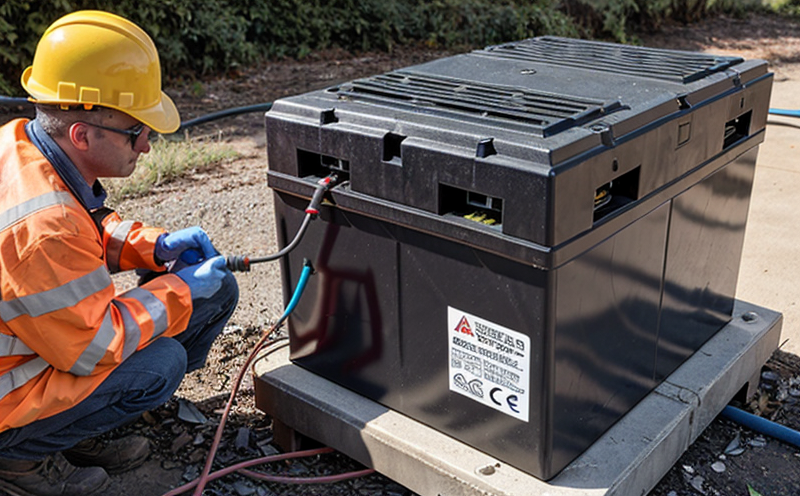IEC 60254-4 Lead-Acid Traction Battery Capacity Testing
The IEC standard 60254-4 outlines specific procedures and requirements for testing the capacity of traction lead-acid batteries. This service is essential for ensuring that these batteries meet stringent performance criteria, particularly in applications where reliability and safety are paramount.
Traction lead-acid batteries find extensive use in electric vehicles (EVs), hybrid electric vehicles (HEVs), and other industrial applications requiring high-capacity power sources. The testing process aims to validate the battery's ability to deliver the specified amount of electrical energy under defined conditions. This is critical for ensuring that the battery can support the vehicle or application demands throughout its operational life.
During this test, a series of discharge cycles are conducted to assess the battery’s capacity. These cycles follow prescribed protocols laid out in IEC 60254-4, which ensures consistency and comparability across different manufacturers and models. The test conditions include temperature control, current monitoring, voltage measurement, and time tracking.
The testing apparatus typically includes a high-capacity discharge rack designed to simulate real-world operating environments. This setup allows for accurate determination of the battery’s capacity under various load conditions. It is important that all equipment used in these tests adheres strictly to the specified standards, ensuring precision and reliability.
Upon completion of the test cycles, detailed reports are generated detailing each discharge cycle's performance metrics such as voltage, current, and temperature. These reports provide a comprehensive overview of the battery's capacity, enabling stakeholders to make informed decisions regarding its suitability for their application.
The IEC 60254-4 standard is widely recognized globally due to its rigorous approach to ensuring product quality and safety. Compliance with this standard not only meets regulatory requirements but also enhances brand reputation by demonstrating commitment to excellence in manufacturing processes.
Understanding the intricacies of these tests helps ensure that batteries are optimized for performance, extending their lifespan while maintaining high levels of reliability. By adhering closely to IEC 60254-4 guidelines during production and quality assurance stages, manufacturers can produce reliable traction lead-acid batteries capable of meeting stringent operational demands.
The importance of accurate testing cannot be overstated; it plays a crucial role in ensuring the safety and efficiency of electric vehicles and other traction applications. Through precise measurement techniques and adherence to international standards like IEC 60254-4, we offer reliable services that contribute significantly towards achieving these goals.
Our team of experts utilizes state-of-the-art facilities equipped with advanced instrumentation capable of delivering accurate results consistently. We pride ourselves on providing robust testing solutions tailored specifically for the needs of our clients within this sector.
Applied Standards
- IEC 60254-4: This standard specifies the procedure for determining the capacity of lead-acid traction batteries, which is crucial for ensuring that these batteries meet stringent performance criteria in various applications.
- ISO/IEC: Compliance: Our laboratory adheres strictly to international standards when conducting tests on lead-acid traction batteries. This ensures consistency and comparability across different manufacturers and models.
The application of such standards is vital for maintaining high-quality products that are safe, reliable, and efficient in their intended use cases.
By adhering closely to these guidelines during production and quality assurance stages, we help ensure the reliability and safety of traction lead-acid batteries produced by our clients. This commitment to quality control contributes significantly towards achieving regulatory compliance while enhancing brand reputation through consistent performance across all product lines.
Benefits
Compliance with IEC 60254-4 offers numerous advantages for manufacturers and users of traction lead-acid batteries. These benefits extend beyond mere adherence to regulatory requirements, encompassing broader improvements in product quality, safety, and overall reliability.
- Better Product Quality: By rigorously testing the batteries according to IEC 60254-4 standards, manufacturers can identify any potential issues early on. This proactive approach ensures that only high-quality products reach the market, thereby enhancing customer satisfaction.
- Increased Safety: The stringent testing procedures prescribed by this standard help prevent accidents caused by underperforming or faulty batteries. Ensuring that each unit meets specified capacity requirements before release adds another layer of protection for both operators and passengers.
- Enhanced Efficiency: Testing according to IEC 60254-4 helps optimize battery performance, leading to improved fuel economy in electric vehicles (EVs) or increased runtime in other traction applications. This results in lower operational costs over the life cycle of the vehicle or machinery.
- Regulatory Compliance: Adhering strictly to international standards like IEC 60254-4 ensures that products are not only safe but also meet all necessary regulatory requirements worldwide. This reduces the risk of legal disputes and penalties associated with non-compliance.
- Better Brand Reputation: Consistently delivering reliable, high-performance batteries that comply with recognized international standards such as IEC 60254-4 can significantly enhance a company's reputation among customers and industry peers. It demonstrates a strong commitment to quality and safety.
In summary, compliance with IEC 60254-4 brings tangible benefits that contribute positively across multiple dimensions including product quality, user safety, operational efficiency, regulatory adherence, and brand image. These advantages make it an indispensable part of the testing process for traction lead-acid batteries.





